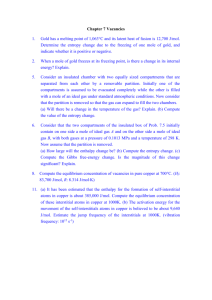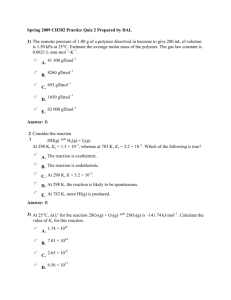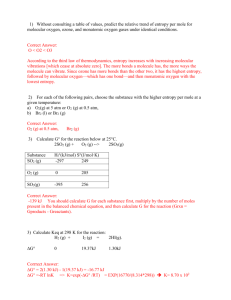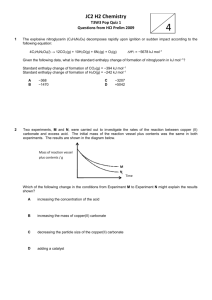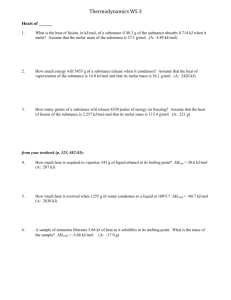Chapter 1 Problems
advertisement
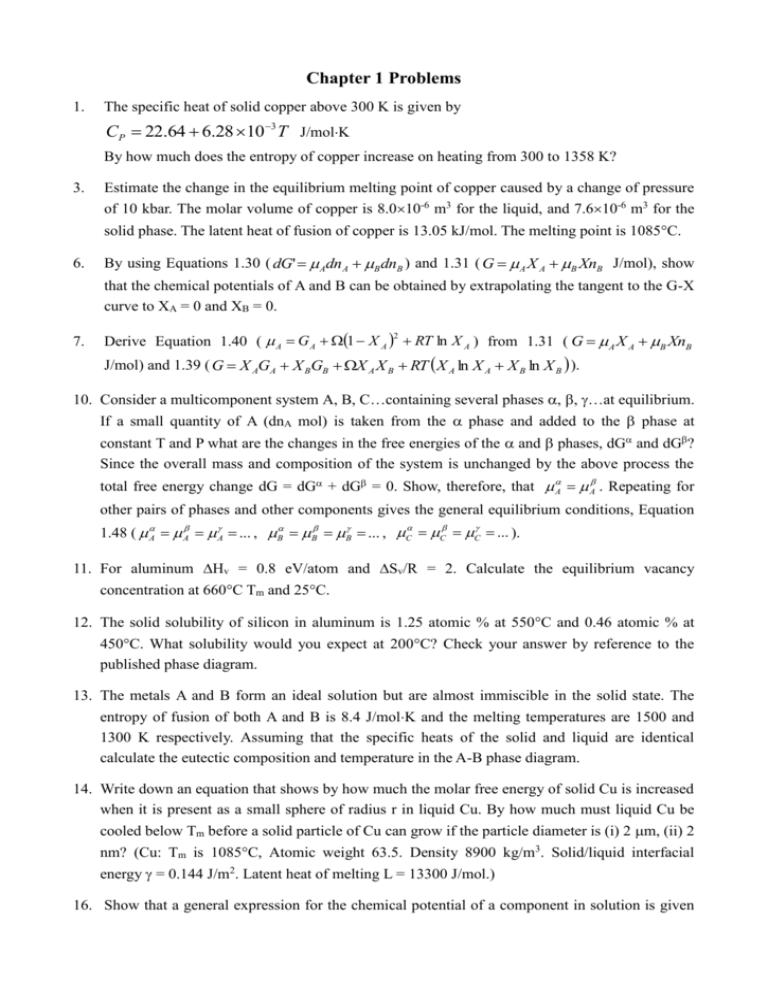
Chapter 1 Problems 1. The specific heat of solid copper above 300 K is given by CP 22.64 6.28 10 3 T J/molK By how much does the entropy of copper increase on heating from 300 to 1358 K? 3. Estimate the change in the equilibrium melting point of copper caused by a change of pressure of 10 kbar. The molar volume of copper is 8.010-6 m3 for the liquid, and 7.610-6 m3 for the solid phase. The latent heat of fusion of copper is 13.05 kJ/mol. The melting point is 1085C. 6. By using Equations 1.30 ( dG' Adn A B dnB ) and 1.31 ( G A X A B XnB J/mol), show that the chemical potentials of A and B can be obtained by extrapolating the tangent to the G-X curve to XA = 0 and XB = 0. 7. Derive Equation 1.40 ( A G A 1 X A RT ln X A ) from 1.31 ( G A X A B XnB 2 J/mol) and 1.39 ( G X AGA X BGB X A X B RT X A ln X A X B ln X B ). 10. Consider a multicomponent system A, B, C…containing several phases , , …at equilibrium. If a small quantity of A (dnA mol) is taken from the phase and added to the phase at constant T and P what are the changes in the free energies of the and phases, dG and dG? Since the overall mass and composition of the system is unchanged by the above process the total free energy change dG = dG + dG = 0. Show, therefore, that A A . Repeating for other pairs of phases and other components gives the general equilibrium conditions, Equation 1.48 ( A A A ... , B B B ... , C C C ... ). 11. For aluminum Hv = 0.8 eV/atom and Sv/R = 2. Calculate the equilibrium vacancy concentration at 660C Tm and 25C. 12. The solid solubility of silicon in aluminum is 1.25 atomic % at 550C and 0.46 atomic % at 450C. What solubility would you expect at 200C? Check your answer by reference to the published phase diagram. 13. The metals A and B form an ideal solution but are almost immiscible in the solid state. The entropy of fusion of both A and B is 8.4 J/molK and the melting temperatures are 1500 and 1300 K respectively. Assuming that the specific heats of the solid and liquid are identical calculate the eutectic composition and temperature in the A-B phase diagram. 14. Write down an equation that shows by how much the molar free energy of solid Cu is increased when it is present as a small sphere of radius r in liquid Cu. By how much must liquid Cu be cooled below Tm before a solid particle of Cu can grow if the particle diameter is (i) 2 m, (ii) 2 nm? (Cu: Tm is 1085C, Atomic weight 63.5. Density 8900 kg/m3. Solid/liquid interfacial energy = 0.144 J/m2. Latent heat of melting L = 13300 J/mol.) 16. Show that a general expression for the chemical potential of a component in solution is given by A G A0 S A T0 T RT ln A X A P P0 Vm where G A0 is the free energy of pure A at temperature T0 and pressure P0, SA is the entropy of A, R is the gas constant, A the activity coefficient for A, XA the mole fraction in solution, Vm is the molar volume which is assumed to be constant. Under what conditions is the above equation valid?



